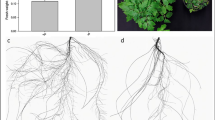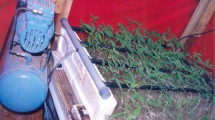Abstract
Exudation of carboxylic anions and protons by plant roots plays an important role in mobilizing soil P under P-deficiency conditions. The objective of this work was to quantify short-term (6 h) carboxylate and H+ exudation by tomato roots in response to P concentration (0, 0.1, 0.5 and 1.0 mt M P) in nutrient solution (Cp). The exudation rate of tri- and dicarboxylates decreased exponentially with increasing Cp, from 0.3 to 0.03 μmol plant−1 6h−1. At low Cp the predominant exudates were fumarate, citrate and succinate, while at Cp=0.5 and 1.0 mt M the prevalent anions were succinate and citrate. The solution pH declined sharply as Cp was lowered from 0.1 (pH=4.2) to 0 mt M P (pH=3.7).
Similar content being viewed by others
References
Amman C and Amberger A 1989 Phosphorus efficiency of buckwheat (Fagopyron esculentum). Z. Pflanzenernähr. Bodenkd. 52, 181-189.
Bar-Yosef B 1996 Root excretions and their environmental effects-Influence on availability of phosphorus. InPlant Roots-The Hidden Half, 2nd ed. Eds. Y Waisel, A Eshel and U Kafkafi pp 581-605. Marcel Dekker Inc., New York.
Bar-Yosef B and Imas P 1995 Phosphorus fertigation and growth substrate effects on dry matter production and nutrient contents in greenhouse tomatoes. Acta Hortic. 401, 337-346.
Dinkelaker B, Romheld V and Marschner H 1989 Citric acid excretion and precipitation of calcium citrate in the rhizosphere of white lupin (Lupinus albusL.) Plant Cell Environ. 12, 285-292.
Fox T R and Comerford N B 1990 Low-molecular weight organic acids in selected forest soils of the Southeastern USA. Soil Sci. Soc. Am. J. 54, 1139-1144.
Gardner WK, Barber D A and Parbery D G 1983 The acquisition of phosphorus by Lupinus albusL. III. The probable mechanism by which phosphorus movement in the soil/root interface is enhanced. Plant Soil 70, 107-124.
Hedley MJ, Nye P H and White R H 1982 Plant-induced changes in the rhizosphere of rape (Brassica napusvar. Emerald) seedlings. II. Origin of the pH change. New Phytol. 91, 31-44.
Hedley MJ, Nye P H and White R H 1983 Plant-induced changes in the rhizosphere of rape (Brassica napusvar. Emerald) seedlings. IV. The effect of rhizosphere phosphorus status on the pH, phosphatase activity and depletion of soil phosphorus fractions in the rhizosphere and on the cation-anion balance in the plants. New Phytol. 95, 69-82.
Heuwinkel H, Kirkby EA, LeBot J and Marschner H 1992 Phosphate deficiency enhances molybdenum uptake by tomato plants. J. Plant Nutr. 15, 549-568.
Hoagland D R and Arnon D J 1938 The water culture method for growing plants without soils. Circ. Calif Agric. Exp. Stn. No. 347.
Hoffland E, van den Boogard R, Nelemans J and Findenegg G 1992 Biosynthesis and root exudation of citric and malic acids in phosphate-starved rape plants. New Phytol. 122, 675-680.
Hoffland E, Findenegg G and Nelemans J 1989 Solubilization of rock phosphate by rape. II. Local exudation of organic acids as a response to P-starvation. Plant Soil 113, 161-165.
Imas P, Bar-Yosef B, Kakafi U and Ganmore-Neumann R 1997 Carboxylic anions and proton excretion by tomato roots in response to ammonium/nitrate ratio and pH in nutrient solution. Plant Soil 191.
Johnson J F, Allan D L and Vance C P 1994 Phosphorus stress-induced proteoid roots show altered metabolism in Lupinus albus. Plant Physiol. 104, 657-665.
Kirkby E A and Mengel K 1967 Ionic balance in different tissues of tomato plants in relation to nitrate, urea and ammonium nutrition. Plant Physiol. 42, 6-14.
Kraffczyk I, Trolldenier G and Beringer H 1984 Soluble root exudates of maize: influence of potassium supply and rhizosphere microorganisms. Soil Biol. Biochem. 16, 315-322.
Lipton D S, Blanchar R W and Blevins D G 1987 Citrate, malate, and succinate concentration in exudates from P-sufficient and P-stressed Medicago sativaL. seedlings. Plant Physiol. 85, 315-317.
Marschner H 1995 Mineral nutrition of higher plants, 2nd ed. Academic Press Limited, London. 674 p.
Miller G W, Shigematsu A, Welkie G W, Motoji N and Szlek M 1990 Potassium effect on iron stress in tomato. II. The effect on root CO2-fixation and organic acid formation. J. Plant Nutr. 13, 1353-1370.
Ohwaki Y and Hirata H 1992 Differences in carboxylic acids among P-starved leguminous crops in relation to carboxylic acid contents in plant tissues and phospholipid level in roots. Soil Sci. Plant Nutr. 38, 235-243.
Petersen W and Bottger M 1991 Contribution of organic acids to the acidification of the rhizosphere of maize seedlings. Plant Soil 132, 159-163.
Rabe E and Lovatt C J 1986 Increased arginine biosynthesis during phosphorus deficiency: a response to the increased ammonia content of leaves. Plant Physiol. 81, 774-779.
SAS Institute 1985 SAS for linear models: a guide to ANOVA and GLM procedures. SAS Inst., Cary, NC.
Schubert S and Mengel K 1989 Important factors in nutrient availability: root morphology and physiology. Z. Pflanzenernähr. Bodenkd. 152, 169-174.
Schwab S M, Menge J A and Leonard R T 1983 Quantitative and qualitative effects of phosphorus on extracts and exudates of sudangrass roots in relation to vesicular-arbuscular mycorrhiza formation. Plant Physiol. 7, 761-765.
Senden MHMN, van der Meer AJGM, Limborgh J and Wolterbeek H Th 1992 Analysis of major tomato xylem organic acids and PITC-derivates of amino acids by RP-HPLC and UV detection. Plant Soil 142, 81-89.
Zhiyu L, Weiming S and Xiaoshui F 1990 The rhizosphere effects of phosphorus and iron in soils. Trans. 14th International Congress of Soil Science, Kyoto, Japan. Volume II, pp 147-152.
Author information
Authors and Affiliations
Rights and permissions
About this article
Cite this article
Imas, P., Bar-Yosef, B., Kafkafi, U. et al. Phosphate induced carboxylate and proton release by tomato roots. Plant and Soil 191, 35–39 (1997). https://doi.org/10.1023/A:1004262730434
Issue Date:
DOI: https://doi.org/10.1023/A:1004262730434




